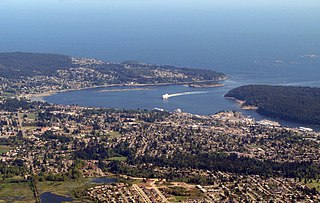Related Research Articles

Nanaimo is a city on the east coast of Vancouver Island in British Columbia, Canada. As of the 2021 census, it had a population of 99,863. It is known as "The Harbour City". The city was previously known as the "Hub City". This was attributed both to its original layout design, where the streets radiated from the shoreline like the spokes of a wagon wheel, and to its centralized location on Vancouver Island. Nanaimo is the headquarters of the Regional District of Nanaimo.

Saysutshun Provincial Park, formally known as Newcastle Island Marine Provincial Park, is a provincial park located on a small island off the coast of Nanaimo, British Columbia, Canada.

New Westminster is a city in the Lower Mainland region of British Columbia, Canada, and a member municipality of the Metro Vancouver Regional District. It was founded by Major-General Richard Moody as the capital of the new-born Colony of British Columbia in 1858, and continued in that role until the Mainland and Island Colonies were merged in 1866. It was the British Columbia Mainland's largest city from that year until it was passed in population by Vancouver during the first decade of the 20th century.
This article discusses Chinatowns in the Americas, urban areas with a large population of people of Chinese descent. The regions include: Canada, the United States, and Latin America.

The Island Rail Corridor, previously the Esquimalt & Nanaimo Railway, is a railway operation on Vancouver Island and is the only remaining railway on Vancouver Island after the closure of the Englewood Railway in November 2017. The Island Corridor Foundation owns the former Esquimalt & Nanaimo Railway corridor. The railway line is 225 kilometres (140 mi) in length from Victoria to Courtenay, known as the Victoria Subdivision, with a branch line from Parksville to Port Alberni known as the Port Alberni Subdivision at 64 kilometres (40 mi) in length, for a total 289 kilometres (180 mi) of mainline track. In 2006, the Island Corridor Foundation acquired the railway's ownership from the Canadian Pacific Railway.

Vancouver Island University is a Canadian public university serving Vancouver Island and coastal British Columbia. Starting as Malaspina College in 1969, it has grown into a university that plays an important role in the educational, cultural, and economic life of the region. The main campus is located in Nanaimo, and there are regional campuses in Duncan and Powell River, as well as a centre in Parksville.

Duncan is a city on southern Vancouver Island in British Columbia, Canada. It is the smallest city by area in Canada. It was incorporated in 1912.
Cassidy is an unincorporated community straddling Haslam Creek. near the east coast of southern Vancouver Island, British Columbia, Canada. The location on BC Highway 19 is about 98 kilometres (61 mi) by road north-west of Victoria, and 14 kilometres (9 mi) south of Nanaimo.
Cumberland is an incorporated village municipality east of Perseverance Creek near the east coast of central Vancouver Island, British Columbia. This Comox Valley community, west of BC Highway 19, is by road about 105 kilometres (65 mi) northwest of Nanaimo, and 10 kilometres (6 mi) southwest of Courtenay.

Departure Bay is a bay in central Nanaimo, British Columbia, on the east coast of Vancouver Island. The surrounding neighbourhood is also referred to as "Departure Bay" —once a settlement of its own, it was amalgamated into the City of Nanaimo in the 1970s.

CKWV-FM is a Canadian radio station located in Nanaimo, British Columbia. It broadcasts on 102.3 FM and is owned by Island Radio, a division of the Jim Pattison Group.

The Chinatown in Victoria, British Columbia is the oldest Chinatown in Canada and the second oldest in North America after San Francisco. Victoria's Chinatown had its beginnings in the mid-nineteenth century in the mass influx of miners from California to what is now British Columbia in 1858. It remains an actively inhabited place and continues to be popular with residents and visitors, many of whom are Chinese-Canadians. Victoria's Chinatown is now surrounded by cultural, entertainment venues as well as being a venue itself. Chinatown is now conveniently just minutes away from other sites of interests such as the Save-On-Foods Memorial Centre, Bay Centre, Empress Hotel, Market Square, and others.
Wellington, formerly a separate district and town, is a neighbourhood of north Nanaimo, on the east coast of southern Vancouver Island, British Columbia.
The Wellington station located in the Wellington area of Nanaimo, British Columbia, was a flag stop on Via Rail's Dayliner service, which ended in 2011. The station is on the Southern Railway of Vancouver Island mainline. The station was named after the town of Wellington which formed around and next to the Wellington Colliery which was named after Arthur Wellesley, 1st Duke of Wellington, a leading British military and political figure in the 19th century.
Chinatowns in Canada generally exist in the large cities of Vancouver, Ottawa, Calgary, Edmonton, Toronto, and Montreal, and existed in some smaller towns throughout the history of Canada. Prior to 1900, almost all Chinese were located in British Columbia, but have spread throughout Canada thereafter. From 1923 to 1967, immigration from China was suspended due to exclusion laws. In 1997, the handover of Hong Kong to China caused many from there to flee to Canada due to uncertainties. Canada had about 25 Chinatowns across the country between the 1930s to 1940s, some of which have ceased to exist.
Extension is an unincorporated community near the east coast of southern Vancouver Island, British Columbia. The location off BC Highway 19 is about 107 kilometres (66 mi) by road northwest of Victoria, and 10 kilometres (6 mi) south of Nanaimo.
The history of Chinese Canadians in British Columbia began with the first recorded visit by Chinese people to North America in 1788. Some 30–40 men were employed as shipwrights at Nootka Sound in what is now British Columbia, to build the first European-type vessel in the Pacific Northwest, named the North West America. Large-scale immigration of Chinese began seventy years later with the advent of the Fraser Canyon Gold Rush of 1858. During the gold rush, settlements of Chinese grew in Victoria and New Westminster and the "capital of the Cariboo" Barkerville and numerous other towns, as well as throughout the colony's interior, where many communities were dominantly Chinese. In the 1880s, Chinese labour was contracted to build the Canadian Pacific Railway. Following this, many Chinese began to move eastward, establishing Chinatowns in several of the larger Canadian cities.
Chinese Canadians are a sizable part of the population in Greater Vancouver, especially in the Chinese communities in the city of Vancouver and the adjoining suburban city of Richmond. The legacy of Chinese immigration is prevalent throughout the Vancouver area.
Lynne Bowen is a Canadian non-fiction writer, historian, professor, and journalist, best known for her popular historical books about Vancouver Island and British Columbia. Over the years, Bowen has won awards such as the Eaton's British Columbia Book Award (1983), the Lieutenant Governor's Medal for Writing British Columbia History (1987), and the Hubert Evans Non-Fiction Prize (1993).
References
- 1 2 3 4 "Introduction Archived 2016-03-04 at the Wayback Machine " (Archive). Nanaimo Chinatowns Project, Malaspina University-College. Retrieved on February 15, 2015.
- 1 2 3 4 5 Willmott, W.E. "Some aspects of Chinese communities in British Columbia Towns" (Archive). BC Studies . No. 1. (Winter 1968-1969). p. 27-36. See profile. -- CITED: p. 33.
- 1 2 3 4 5 6 "Chinese Community" (Archive). Vancouver Island University. Retrieved on February 15, 2015.
- 1 2 3 4 5 6 Lai, David Chuenyan. Chinatowns: Towns within Cities in Canada. UBC Press, October 1, 2007. ISBN 0774844183, 9780774844185. p. 39.
- ↑ Lai, David Chuenyan. Chinatowns: Towns within Cities in Canada. UBC Press, October 1, 2007. ISBN 0774844183, 9780774844185. p. 45.
- ↑ Lai, David Chuenyan. Chinatowns: Towns within Cities in Canada. UBC Press, October 1, 2007. ISBN 0774844183, 9780774844185. p. 73.
- 1 2 Lai, David Chuenyan. Chinatowns: Towns within Cities in Canada. UBC Press, October 1, 2007. ISBN 0774844183, 9780774844185. p. 77.